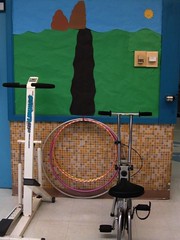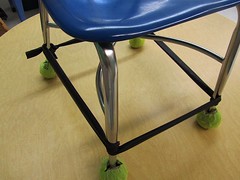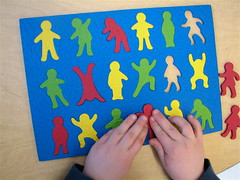Join the occupational therapists at Hosmer School, always searching for ways to improve school function and student participation!
Wednesday, January 19, 2011
National Handwriting Day
Friday, January 07, 2011
Stepping Out
Here is our "Get Moving" station right inside out room. Students start or end their sessions with a boost. Others students come by for a 5 minute alertness break.
What do you have hanging around your basement?
Thursday, January 06, 2011
Containment
Wednesday, January 05, 2011
Wiggling Feet
Let kids move!
Thursday, September 23, 2010
Moving Day
Sunday, June 13, 2010
Great OT Blog
Saturday, June 12, 2010
Connect the Dots
Monday, March 01, 2010
How To...

There is something appealing about completing something in 5 steps. Displaying these 5 steps can be accomplished with a simple list, but check out how it is done using a mind map. Certain students may find this "big idea", visual approach very helpful. See for yourself at Paul Foreman's blog, Mind Map Inspiration.
Saturday, February 27, 2010
"At Attention" vs. Topsy Turvy
I have a fourth grade student with autism. His instructional assistant is a little perplexed by his listening style, but doesn't try to change it. "He'll sit leaning off the chair with his head upside down but when I ask him about what the teacher was saying, he knows it all." As an OT, I recognize that his is getting needed vestibular input through the positional change in his head. This can be quite alerting. As a student of Tai Chi, I can hear my instructor say. "Everybody needs to spend some part of their day upside down."
I have another fourth grade boy with ADHD who struggles to stay focused in his seat. He disrupts others by talking and moving around. I asked him what would help him in class. Without hesitation he said "a chair that swivels". I had just visited the site The Third Teacher and read this passage:
Idea # 22 fom the site is Swivel to Attention
‘Growing bodies have a natural need to move,’ explains Dr. Dieter Breithecker, Europe’s foremost expert on the relationship between ergonomic design in educational furniture and the physical development of school children. ‘Increased opportunities to move while seated, including rocking, swiveling, and rolling, improve blood flow and oxygen to the brain, thereby increasing attention and concentration levels.’
Give students furniture that lets them twist and lean safely. The movement will increase their ability to concentrate.My student knew what he needed. There is a biological need behind it. It is not just something "fun and frivolous".
Know what "participation" looks like for your students.
Friday, December 04, 2009
Bubblewrap...The Real Stuff or The iPhone App?
Why not use both? It follows the UDL principle of multiple means of engagement!
Saturday, November 21, 2009
Sweeping Off the Cobwebs of this Blog
 Habits...they are good when they are established, but boy can they break down! I have gotten out of the "habit" of communicating with this blog, but I am jumping right back into it. I liken it to jumping into Walden Pond which I did yesterday - a bit chilly but invigorating!
Habits...they are good when they are established, but boy can they break down! I have gotten out of the "habit" of communicating with this blog, but I am jumping right back into it. I liken it to jumping into Walden Pond which I did yesterday - a bit chilly but invigorating!I will start again with one thing I learned this morning on Twitter (I got this idea from my friend Karen Janowski over at her blog).
Today's find was an article on FLOW, especially as it relates to teenage learners. I think you will find it interesting!
Wednesday, September 09, 2009
Today is...
Here are some fun activities you can do in class today to celebrate the number nine. Thanks to Jen at Far-Out Links to Learning. I think I'll have my students take nine deep breaths to start off their morning.
Wednesday, September 02, 2009
Summer Ends

Summer is a valuable time for removing yourself from routine tasks and dreaming a bit. Where did your path lead you? Are your ready for the adventure of school?
I once asked the three year old daughter of friends how her parents were doing. She responded, "Same old, same old."
Really? How can anything in your life be "same old, same old" when you are only three? Can we describe our classrooms and work in school in a similar manner? Bring in your dreams, new designs and fresh approaches. Keep learning. Join twitter for your professional growth. Let the journey begin!
Tuesday, September 01, 2009
Classroom Jobs - Think Digital
What other "digital jobs "can you add to you class job list? Add a comment and I will create a post of all your ideas.
Tuesday, July 21, 2009
The Power of Our Hands


OTs have a fascination with hands. It is through our hands that we interact with the world around us. Our hands calm others, take in information, manipulate tools, create masterpieces and are a vehicle for our imagination. Recently we have limited our hands in school to pencils and books. Are our hands having even less a role in this digital age we live in? Watch Pattie Maes from the MIT Media Lab discuss new technology that uses our hands and natural gestures to interact with our environment.
Wednesday, June 03, 2009
Webspiration is Open for (Free) Business Again!

Now you can get a free account to My Webspiration, an online web mapping tool. They opened the site up to new users again, so go for it. MyWebspiration
Wednesday, March 25, 2009
UDL in the Skies OR Soaring Senses
The Rapping Flight Attendant - Watch more Funny Videos
Using Winnie Dunn's classification of sensory patterns, I would identify this particular flight attendant as a "sensory seeker". He added increased sensory input to his typical routine to keep himself and the passengers more alert. Check out Winnie Dunn's book, Living Sensationally - Understanding your Senses to learn more about sensory patterns in everyday life.
Thanks to @rmbyrne for his blog post highlighting this video. Check out his blog Free Technology for Teachers for a wealth of resources at your fingertips.
Friday, February 20, 2009
Seeking Information

Would you be so kind to complete this short form if you work with students on the autism spectrum. We will share the results with you!
photo citation: http://www.flickr.com/photos/paulworthington/82648702/
Thursday, January 22, 2009
Pros, No Cons @EduCon
 I am so excited to be heading down to Philadelphia tomorrow for EduCon 2.1. It is a wonderful experience driven by these guiding principles:
I am so excited to be heading down to Philadelphia tomorrow for EduCon 2.1. It is a wonderful experience driven by these guiding principles:1) Our schools must be inquiry-driven, thoughtful and empowering for all members
2) Our schools must be about co-creating -- together with our students -- the 21st Century Citizen
3) Technology must serve pedagogy, not the other way around.
4) Technology must enable students to research, create, communicate and collaborate
5) Learning can -- and must -- be networked.
If you are not there, you can attend virtually...session recordings will be embedded on the wiki pages. Take advantage of the learning!
Thursday, January 08, 2009
Learn From the Animals

We've had our fair share of ice here in the Boston area recently. Yesterday the Boston Globe gave some tips on navigating safely on this slippery surface. Their main suggestion was to walk like a penguin. It is such a great visual image, isn't it? Although it looks funny, it's not as silly as it seems.
- Keep your knees loose and lower your center of gravity.
- Use a wide based gait with your feet pointed out slightly.
- Walk flat footed on troubled areas and take shorter steps.
- Extend your arms to the sides to keep your balance.
These few changes to your body mechanics may just keep you on your feet. Who wants to try managing on crutches or with your arm in a sling?
image by odolphie
Friday, December 05, 2008
Happiness - Pass it on!
 photo by mathewlees
photo by mathewleesRead the full article.
Turning Trash Into Treasure
Sunday, October 26, 2008
Changing Disabilities To Possibilities
Learn in the Comfort of Your Own Home or School
 Are you listening to the conversations? Going on right now is a free online conference for k - 12 educators. Check it out at the K12 Online Conference 2008. Listen anytime, anywhere. Listen by yourself or with your colleagues. Grab that cup of coffee and chose from among 40 different presentations (all 20 minutes in length). Let me know which ones you enjoyed...
Are you listening to the conversations? Going on right now is a free online conference for k - 12 educators. Check it out at the K12 Online Conference 2008. Listen anytime, anywhere. Listen by yourself or with your colleagues. Grab that cup of coffee and chose from among 40 different presentations (all 20 minutes in length). Let me know which ones you enjoyed...
Wednesday, October 01, 2008
Making it Count!
 On my previous post, Jeff Utecht left a comment which I rejected accidentally when I was moderating it. My only defense was that it was way too early in the morning and I didn't have enough coffee. At any rate, I copied the comment from my email and pasted it here...
On my previous post, Jeff Utecht left a comment which I rejected accidentally when I was moderating it. My only defense was that it was way too early in the morning and I didn't have enough coffee. At any rate, I copied the comment from my email and pasted it here...The best part about moving parent communication online is that you can track who visits and reads the website. We never could do that when we sent the paper copy home in student backpacks. A great way to 'sell' teachers on moving to communicating digitally is to embed a stat counter on the site so they can see that people are visiting and reading.I can't agree with him more. It is so motivating to see that people actually are reading what you put out.
I use clustrmaps as a quick visual. This world map gives you a global glimpse of who is stopping by your site. I also use stat counter. It gives me information I didn't know I wanted. I can see how many people visited on a given day, what cities they came from and how much time they spent on the site.
Monday, September 29, 2008
Parent Collaboration - Reflection # 5
 Collaborating with parents is so important. I often wonder how can we do a better job. I first came upon Parents as Partners website that covers the topic from head to toe. In addition to the website, they have a regular webcast with Ed Tech Talk. It broadcasts on the 1st and 3rd Monday of each month and shares best practices in engaging parents and teachers in conversations about families and schools. Check in Monday 9:00 pm EST. The hosts for the show are Lorna Costantini, Matt Montagne and Rhoda Cipparone.
Collaborating with parents is so important. I often wonder how can we do a better job. I first came upon Parents as Partners website that covers the topic from head to toe. In addition to the website, they have a regular webcast with Ed Tech Talk. It broadcasts on the 1st and 3rd Monday of each month and shares best practices in engaging parents and teachers in conversations about families and schools. Check in Monday 9:00 pm EST. The hosts for the show are Lorna Costantini, Matt Montagne and Rhoda Cipparone. Then I read Jeff Utecht's blog post on Parent Conmmunication: From Print to Digital. As teachers move from paper newsletters to online communication, he offers 5 great suggestions on how to communicate in a digital format.
One of our principal's goal this year is to reduce the amount of copies made in the school. I think this is a great first step!
photo citation: .p a n e.
Sunday, September 28, 2008
Does Learning Stop After You Leave the Schoolyard - Reflection # 4
 Does learning stop when the bell rings and your students leave the four walls of your classroom?
Does learning stop when the bell rings and your students leave the four walls of your classroom?We were on Second Beach in Middletown, RI this summer when we discovered a sand dollar. We thought this was an odd find on such a northern beach. The kids started to wonder if sand dollars where indigenous to this area. Wikipedia and google were not available. Luckily a teenager had her cell phone and I had the place to get the answer, even on the beach...ChaCha.
Mobile Answers. Just call. Just text. Just ask. We did. Within a few minutes, we received a text message explaining that they could be found in shallow coastal waters anywhere in the world, as far north as Alaska. This prompted more questions. What animal lived inside? In a few minutes a text came back explaining they were Echinoids, spiny skinned creatures. Their relations included the sea lily, the sea cucumber, the star fish and the sea urchin. Several more questions were asked and answered. I marveled that learning could take place anywhere. Yes, sitting on a beach in Rhode Island, sparked by a curious find of a sand dollar.
The cell phone is a handy tool. Imagine being on a field trip to pick apples and someone wonders how many types of apples there are in North America. I have the answer...I just asked ChaCha. Now you try. It's free (standard text message fees apply).
Text 242242
Call 1.800.2CHACHA
Nature Lovers - Reflection #3
Summertime is a time to connect with nature. If you happen to be close to the water, you have daily reminders of this. I always know when sunrise and sunset is, as well as high and low tide. This creates a rhythm to the day that effects all that I do.
In the summer edition of Tufts Magazine, there was an article titled What’s lost when kids lose touch with nature? In it, W. George Scarlett talks about the disconnect with the natural world. No longer are kids let loose to play in the woods or to roam the outside. Instead, they are indoors connected to TV and video games or outdoors in organized sports. This alienation from nature is a new focus of research. Is there a connection to obesity and attention deficit disorder in children? Not so long ago, many classrooms had a room pet. This taught the students care taking and promoted wonder. I haven't seen one in years.
Howard Gardner has added naturalist intelligence to his list of multiple intelligences. Do you have a student who is "nature smart"? Take time to gaze at a spider web and observe critters outside the school yard. Write nature journals and embed nature in math problems. How can you connect nature to your classroom?
How Much Movement Do You Need? (Reflection # 2)
How much movement does each individual student need? It will vary just as it does for adults. Granted, some are satisfied with what they get in the typical day: walking to specials, moving around the room to get materials and running around at recess. But we all know there are students who are natural movers. They demand a great amount of movement just to reach their threshold and stay on task. How are we providing this input for them beyond what is naturally available in the school day?
At Hosmer, we have power stations in the hallways to give a quick boost to students as they transition. In the classroom, students stand to work or sit on Movin' Sit cushions. Some children require motor breaks in which they are given 5 minutes to move on a scooter board, ride a roller racer, jump on a trampoline or run up and down the stairs.
What ideas do you have? How can we better accommodate these movers and make them more productive during the school day?












